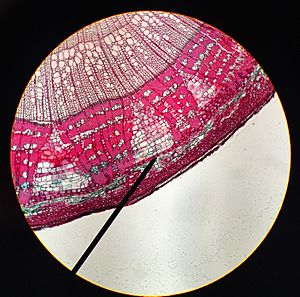Cork cambium facts for kids

Cork cambium is a tissue in many vascular plants as part of the bark (periderm).
The cork cambium is a lateral meristem and is responsible for secondary growth that replaces the epidermis in roots and stems. It is found in woody and many herbaceous dicots, gymnosperms and some monocots, which usually have no secondary growth.
Cork cambium is one of the plant's meristems - the tissues that consist of embryonic (not specialized) cells from which the plant grows. It is one of the many layers of bark, between the cork and primary phloem. The function of cork cambium is to produce the cork, a tough protective material.
Synonyms for cork cambium are bark cambium, pericambium or phellogen.
Economic importance
- Commercial cork comes from the bark of the cork oak (Quercus suber). Cork has many uses including wine bottle stoppers, bulletin boards, coasters, hot pads to protect tables from hot pans, insulation, sealing for lids, flooring, gaskets for engines, handles for tennis rackets, etc.
- Many types of bark are used as mulch.
Other pages
Images for kids
-
Quercus suber (cork oak) bark, Portugal
See also
 In Spanish: Felógeno para niños
In Spanish: Felógeno para niños


